2013 Peugeot 508 Hybrid ESP
[x] Cancel search: ESPPage 139 of 340
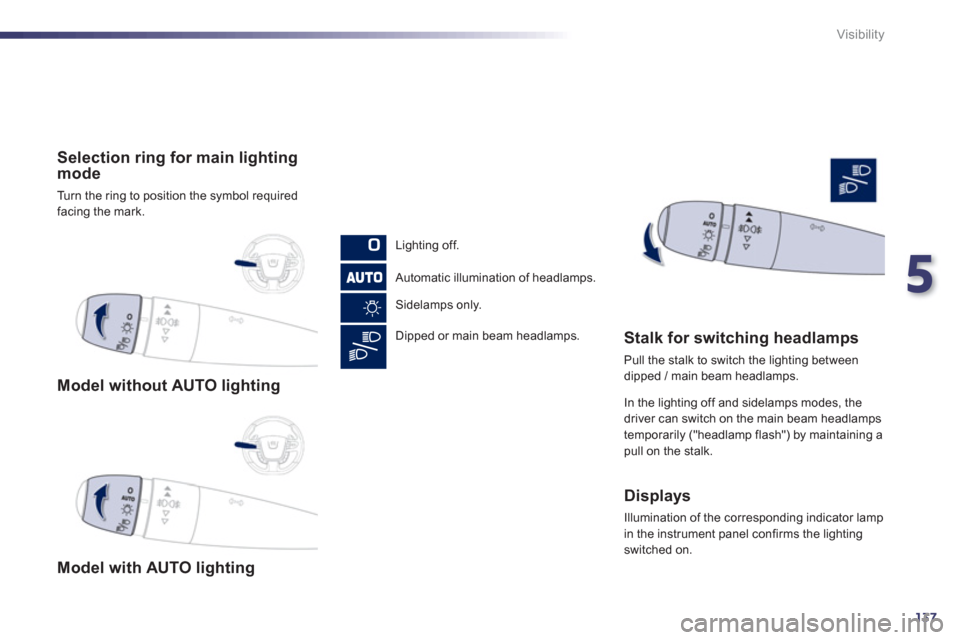
5
137
Visibility
Model without AUTO lighting
Model with AUTO lighting
Selection ring for main lighting mode
Turn the ring to position the symbol required
facing the mark.
Li
ghting off.
Automatic illumination of headlamps.
Sidelamps onl
y.
Dipped or main beam headlamps.
Stalk for switching headlamps
Pull the stalk to switch the lighting between
dipped / main beam headlamps.
In the li
ghting off and sidelamps modes, the driver can switch on the main beam headlamps
temporaril
y ("headlamp flash") by maintaining apull on the stalk.
Displays
Illumination of the corresponding indicator lamp
in the instrument panel confirms the lighting switched on.
Page 140 of 340
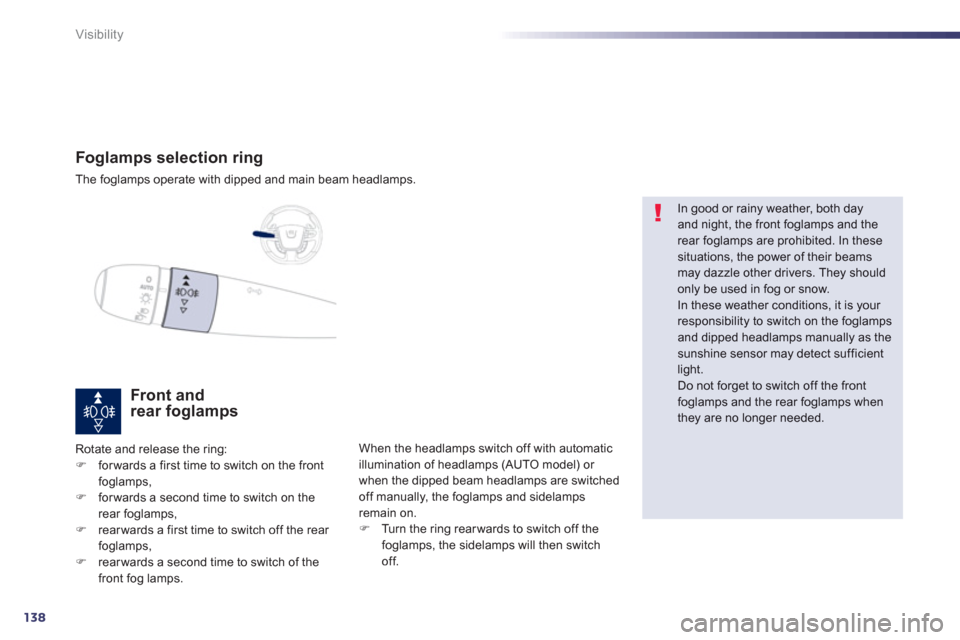
138
Visibility
Foglamps selection ring
The foglamps operate with dipped and main beam headlamps.
Front and rear foglamps
Rotate and release the ring: Fforwards a first time to switch on the frontfoglamps, Fforwards a second time to switch on therear foglamps, Frearwards a first time to switch off the rear
foglamps, Frearwards a second time to switch of the
front fog lamps. When the headlamps switch off with automatic
illumination of headlamps
(AUTO model) or
when the dipped beam headlamps are switched
o
ff manually, the foglamps and sidelampsremain on.F Turn the ring rear wards to switch off the foglamps, the sidelamps will then switchoff.
In good or rainy weather, both day and night, the front foglamps and the rear foglamps are prohibited. In these situations, the power of their beams may dazzle other drivers. They shouldonly be used in fog or snow.
In these weather conditions, it is your responsibility to switch on the foglamps and dipped headlamps manually as the sunshine sensor may detect sufficientlight.
Do not forget to switch off the front foglamps and the rear foglamps when they are no longer needed.
Page 142 of 340
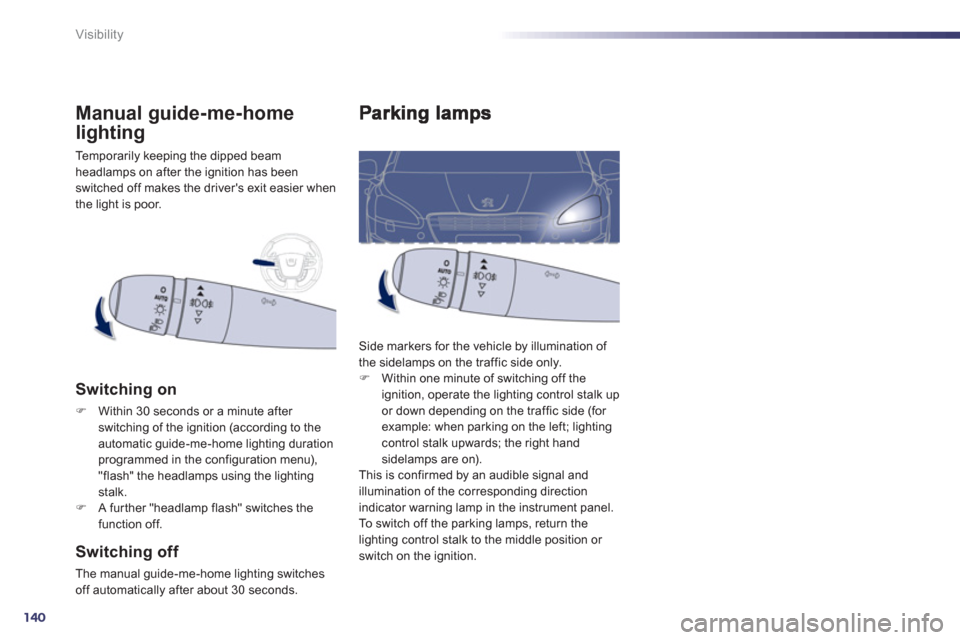
140
Visibility
Side markers for the vehicle by illumination of
the sidelamps on the traffic side only. F Within one minute of switching off the
ignition, operate the lighting control stalk upor down depending on the traffic side (for example: when parking on the left; lightingcontrol stalk upwards; the right hand sidelamps are on).
This is confirmed by an audible signal and
illumination of the corresponding direction
indicator warning lamp in the instrument panel.
To switch off the parking lamps, return the
lighting control stalk to the middle position or
switch on the ignition.
Temporarily keeping the dipped beam
headlamps on after the ignition has beenswitched off makes the driver's exit easier when
the light is poor.
Manual guide-me-home
lighting
Switching on
FWithin 30 seconds or a minute after
switching of the ignition (according to theautomatic guide-me-home lighting durationprogrammed in the configuration menu), "flash" the headlamps using the lighting stalk.FA further "headlamp flash" switches the
function off.
Switching off
The manual guide-me-home lighting switches
off automatically after about 30 seconds.
Page 144 of 340
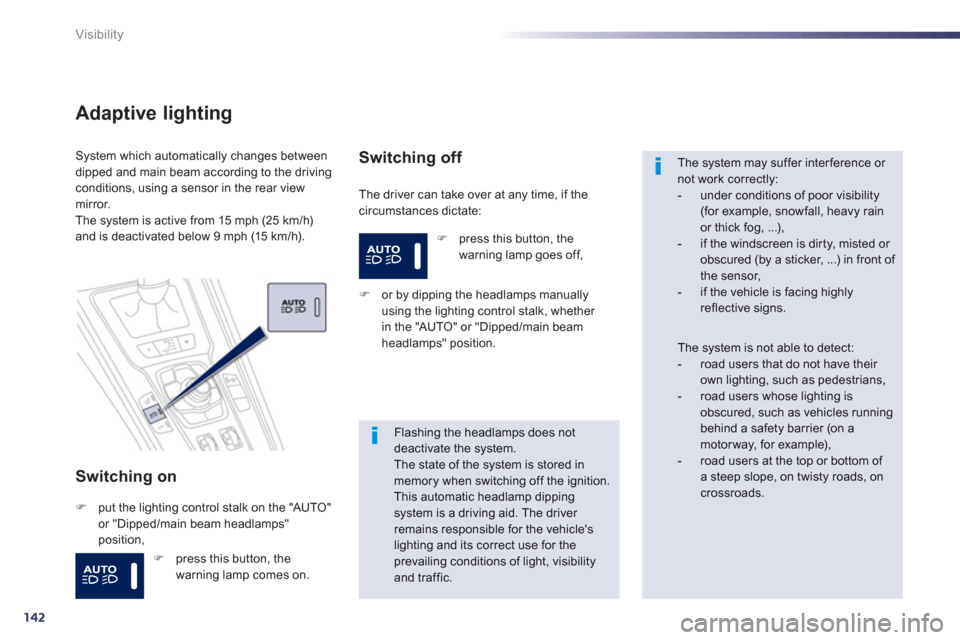
142
Visibility
Adaptive lighting
Switching on
The driver can take over at any time, if thecircumstances dictate:
System which automatically changes betweendipped and main beam according to the driving conditions, using a sensor in the rear view mirror.
The system is active from 15 mph (25 km/h) and is deactivated below 9 mph (15 km / h).
Fput the lighting control stalk on the "AUTO"
or "Dipped/main beam headlamps"
position,
Switching off
F
or by dipping the headlamps manually using the lighting control stalk, whether
in the "AUTO" or "Dipped/main beam
headlamps" position.
Flashing the headlamps does notdeactivate the system.The state of the system is stored in memory when switching off the ignition. This automatic headlamp dipping system is a driving aid. The driver remains responsible for the vehicle'slighting and its correct use for theprevailing conditions of light, visibility and traffic.
The system may suffer interference or not work correctly:
- under conditions of poor visibility(for example, snowfall, heavy rain or thick fog, ...),
- if the windscreen is dir ty, misted or obscured (by a sticker, ...) in front of the sensor,
- if the vehicle is facing highly reflective signs.
The system is not able to detect:
- road users that do not have their own lighting, such as pedestrians,
- road users whose lighting isobscured, such as vehicles running behind a safety barrier (on amotorway, for example),
- road users at the top or bottom of a steep slope, on twisty roads, oncrossroads.
Fpress this button, the
warning lamp goes off,
F press this button, the
warning lamp comes on.
Page 153 of 340
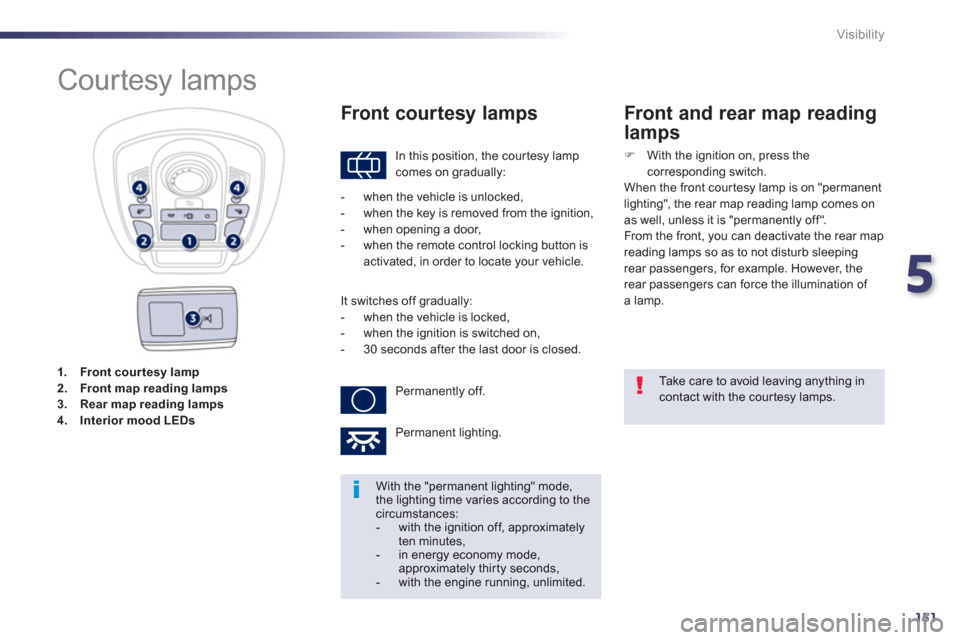
5
151
Visibility
1.Front cour tesy lamp2.Front map reading lamp s3.Rear map reading lamps4.Interior mood LEDs
Courtesy lamps
In this position, the cour tesy lamp comes on gradually:
Front courtesy lamps
Take care to avoid leaving anything in contact with the cour tesy lamps.
With the "permanent lighting" mode, the lighting time varies according to thecircumstances: - with the ignition off, approximatelyten minutes,- in energy economy mode, approximately thirty seconds,- with the engine running, unlimited.
- when the vehicle is unlocked,
- when the ke
y is removed from the ignition,
- when opening a door,
- when the remote control locking button is
activated, in order to locate your vehicle.
It switches off
gradually:
- when the vehicle is locked,
- when the ignition is switched on,
- 30 seconds after the last door is closed.
Permanentl
y off.
Permanent lighting.
Front and rear map reading
lamps
F
With the ignition on, press the
corresponding switch.
When the front courtesy lamp is on "permanent
lighting", the rear map reading lamp comes on
as well, unless it is "permanentl
y off".
From the front, you can deactivate the rear map
reading lamps so as to not disturb sleeping
rear passengers, for example. However, the
rear passengers can force the illumination of
a lamp.
Page 167 of 340
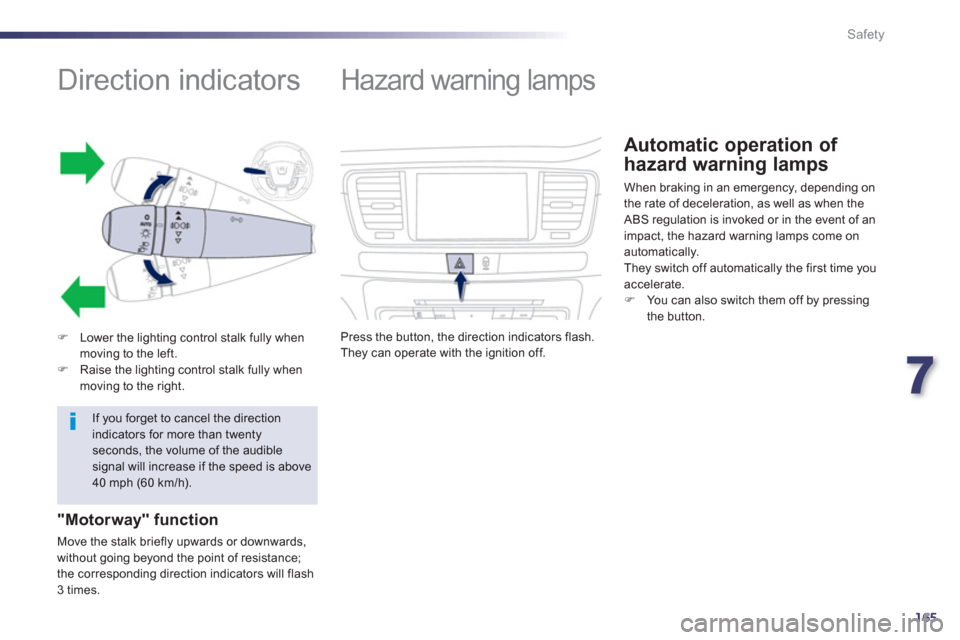
7
165
Safety
Direction indicators
F
Lower the lighting control stalk fully when moving to the left. F
Raise the lighting control stalk fully when moving to the right.
"Motorway" function
Move the stalk briefly upwards or downwards,
without going beyond the point of resistance;
the corresponding direction indicators will flash 3 times.
If you forget to cancel the direction indicators for more than twenty seconds, the volume of the audible signal will increase if the speed is above40 mph (60 km/h).
Hazard warning lamps
Press the button, the direction indicators flash.
They can operate with the ignition off.
Automatic operation of
hazard warnin
g lamps
When braking in an emergency, depending on
the rate of deceleration, as well as when the ABS regulation is invoked or in the event of animpact, the hazard warning lamps come on
automatically.
They switch off automatically the first time you accelerate.F
You can also switch them off by pressingthe button.
Page 169 of 340
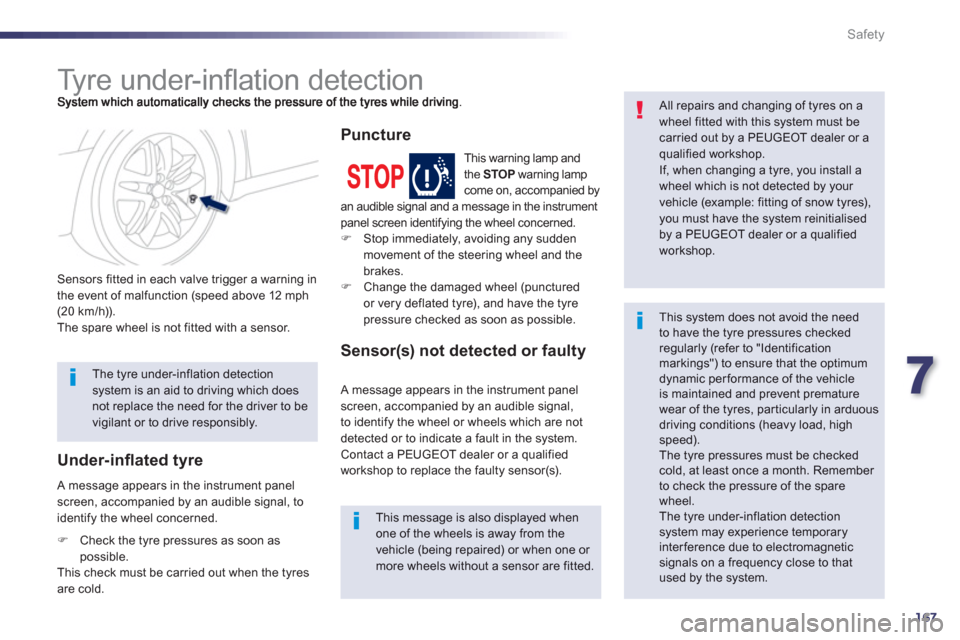
7
167
Safety
Ty r e u n d e r - i nfl ation detection
Sensors fitted in each valve trigger a warning in
the event of malfunction (speed above 12 mph (20 km/h)).
The spare wheel is not fitted with a sensor.
All repairs and changing of tyres on awheel fitted with this system must becarried out by a PEUGEOT dealer or a qualified workshop.
If, when changing a tyre, you install awheel which is not detected by your vehicle (example: fitting of snow tyres), you must have the system reinitialised
by a PEUGEOT dealer or a qualifiedworkshop.
This message is also displayed whenone of the wheels is away from thevehicle (being repaired) or when one or more wheels without a sensor are fitted.
The tyre under-inflation detectionsystem is an aid to driving which doesnot replace the need for the driver to bevigilant or to drive responsibly.
This system does not avoid the needto have the tyre pressures checkedregularly (refer to "Identification markings") to ensure that the optimumdynamic performance of the vehicleis maintained and prevent premature wear of the tyres, particularly in arduousdriving conditions (heavy load, highspeed). The tyre pressures must be checked cold, at least once a month. Remember to check the pressure of the spare wheel.
The tyre under-inflation detection system may experience temporary interference due to electromagnetic signals on a frequency close to that used by the system.
A message appears in the instrument panelscreen, accompanied by an audible signal, to
identify the wheel concerned.
Under-infl ated tyre
This warning lamp and
the STOPwarning lamp come on, accompanied by an audible signal and a message in the instrument panel screen identifying the wheel concerned. FStop immediately, avoiding any sudden
movement of the steering wheel and thebrakes.
FChange the damaged wheel (punctured
or very deflated tyre), and have the tyre
pressure checked as soon as possible.
Puncture
A message appears in the instrument panel
screen, accompanied by an audible signal,
to identify the wheel or wheels which are not
detected or to indicate a fault in the system.Contact a PEUGEOT dealer or a qualifiedworkshop to replace the faulty sensor(s).
Sensor(s) not detected or faulty
F
Check the tyre pressures as soon aspossible.
This check must be carried out when the tyres
are cold.
Page 172 of 340
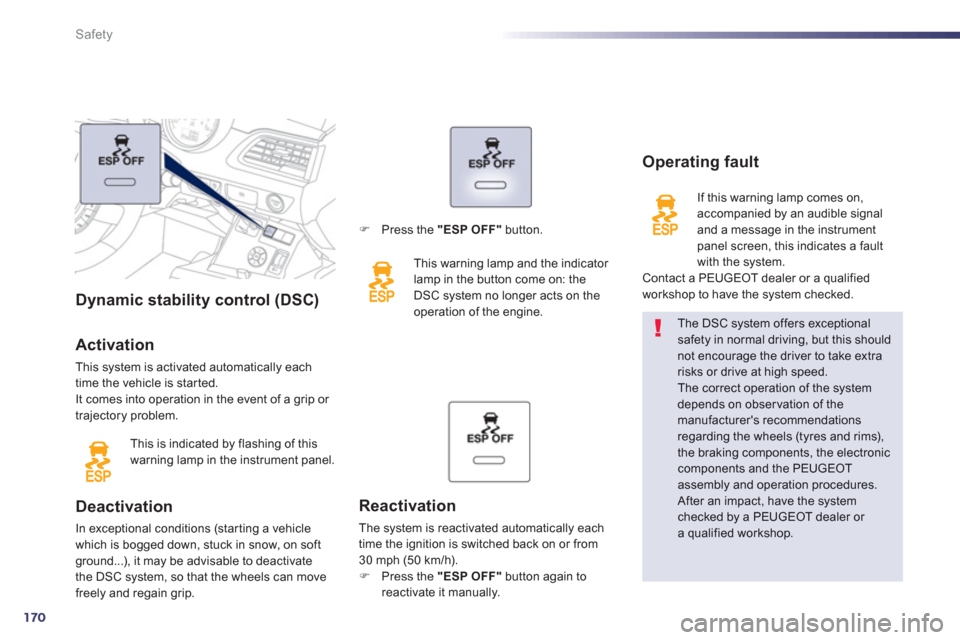
170
Safety
Dynamic stability control (DSC)
Activation
This system is activated automatically each
time the vehicle is started.
It comes into operation in the event of a grip or
trajectory problem.
This is indicated b
y flashing of this
warning lamp in the instrument panel.
Deactivation
In exceptional conditions (starting a vehicle
which is bogged down, stuck in snow, on softground...), it may be advisable to deactivate
the DSC system, so that the wheels can move
freely and regain grip.
The DSC system offers exceptional safety in normal driving, but this should not encourage the driver to take extra risks or drive at high speed.
The correct operation of the system depends on obser vation of the manufacturer's recommendationsregarding the wheels (tyres and rims),the braking components, the electronic components and the PEUGEOTassembly and operation procedures.
After an impact, have the systemchecked by a PEUGEOT dealer or a qualified workshop.
Operating fault
If this warning lamp comes on,
accompanied by an audible signal
and a messa
ge in the instrument
panel screen, this indicates a fault
with the system.
Contact a PEUGEOT dealer or a qualified
workshop to have the system checked.
Reactivation
The system is reactivated automatically eachtime the ignition is switched back on or from
30 mph (50 km/h).F Press the "ESP OFF"
button again to
reactivate it manually.
F Press the "ESP OFF"
button.
This warnin
g lamp and the indicator
lamp in the button come on: the
D
SC system no longer acts on the
operation of the engine.